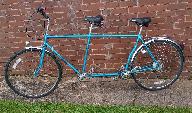All forum posts
Frame designs
Hi Guys.
I've been looking through a Tandem East magazine, its a US magazine, and it has advertisements for maybe 30 makes and models of tandem, and strangely, most have very simple looking frames. They don't have the tube from headset to rear BB or diagonals of any sort. I'd cautiously describe it as a front trapezium, a centre parallelogram and a conventional triangle at the rear. Some are designated for racing and others for tours. Are materials or designs stronger, or are expectations lower nowadays.
Yours very puzzled
Barry
Barry,
The short answer is that materials and designs has moved on. Co-Motion was one of the first companies to use the 'open' design. By using tubing of greater strength and diameter for the top,down and seat tubes, stiffness is gained and therefore the lateral tubes can be removed. This also means if using S&S couplers, the overall frame costs and weight is less as there are 2 less couplers.
Our Landescape frames still retain the lateral tube as the tandem specific butted tubing used in manufacturing them has a very thin wall thickness. Retaining the large diameter lateral while having a small diameter top tube gives a very stiff frame, but one that is comfortable to ride. The weight difference between the Co-Motion (aluminium) and Landescape designs is negligible. Both are considerable stiffer, but less jarring to ride that other aluminium frames.
Not sure why looking at a US Tandems East catalogue is the first time you have seen the 'open' designs - we have been selling the Co-Motion designs here in the UK for nearly 5 years.
Rob
The Tandem Shop
Thanks for that overview Robert. Clearly, I've led a sheltered life.
bast regards
Barry
: Barry,
: The short answer is that materials and designs has moved on. Co-Motion was
: one of the first companies to use the 'open' design. By using tubing of
: greater strength and diameter for the top,down and seat tubes, stiffness
: is gained and therefore the lateral tubes can be removed. This also means
: if using S&S couplers, the overall frame costs and weight is less as there
: are 2 less couplers.
: Our Landescape frames still retain the lateral tube as the tandem specific
: butted tubing used in manufacturing them has a very thin wall thickness.
: Retaining the large diameter lateral while having a small diameter top
: tube gives a very stiff frame, but one that is comfortable to ride. The
: weight difference between the Co-Motion (aluminium) and Landescape designs
: is negligible. Both are considerable stiffer, but less jarring to ride
: that other aluminium frames.
: Not sure why looking at a US Tandems East catalogue is the first time you
: have seen the 'open' designs - we have been selling the Co-Motion designs
: here in the UK for nearly 5 years.
: Rob
: The Tandem Shop
Rob, even if larger (and stronger) tubing can compensate for lack of triangulation, this presumably puts more stress on the joints - both of the front and of the middle section of the frame. Do these frames last as long as traditional ones - and is anyone confident enough to make un-braced triplet frames?
Tim
Tim,
As the tubes are larger diameter, the joints are therefore bigger and therefore have more material in the joint and therefore proportionally stronger. The tubing may/will also be thicker at the joint to add strength. Please be aware that manufactures do test their frames beyond 'normal' use to ensure that they are safe to to use and will last more than the lifetime of the original owner.
Having spent over 30 years in the bicycle industry it always puzzles and frustrates me that there is an assumption by potential customers that manufactures risk their customers' lives by making frames or equipment that may fail. If anything, products tend to be over engineered to cope with a range of conditions and rider weights that they have no control over. e.g. I ride a 57cm road bike and weigh 65kg someone else who rides the same size frame could weigh 110kg - manufactures will make for the 110kg rider or put a weight limit on a particular product to be safe from any litigation.
Triplets are a whole different set of design consideration and a minute part of the market. But yes, they are made in in an 'open' design. See here: https://co-motion.com/bikes/periscope-trident
Rob
: Tim,
: As the tubes are larger diameter, the joints are therefore bigger and
: therefore have more material in the joint and therefore proportionally
: stronger. The tubing may/will also be thicker at the joint to add
: strength. Please be aware that manufactures do test their frames beyond
: 'normal' use to ensure that they are safe to to use and will last more
: than the lifetime of the original owner.
: Having spent over 30 years in the bicycle industry it always puzzles and
: frustrates me that there is an assumption by potential customers that
: manufactures risk their customers' lives by making frames or equipment
: that may fail. If anything, products tend to be over engineered to cope
: with a range of conditions and rider weights that they have no control
: over. e.g. I ride a 57cm road bike and weigh 65kg someone else who rides
: the same size frame could weigh 110kg - manufactures will make for the
: 110kg rider or put a weight limit on a particular product to be safe from
: any litigation.
: Triplets are a whole different set of design consideration and a minute part
: of the market. But yes, they are made in in an 'open' design. See here:
: https://co-motion.com/bikes/periscope-trident
: Rob
Hi Rob,
Thanks for your further comments on frames. I’m reminded of the earliest tandems where the chains apparently jumped off when they flexed under pedalling. Given the simple rigidity of triangles and the extra material, strength and presumably cost needed for ‘open’ frames, I doubt if I’ll be going for one, even if they do look extra cool.
I’m don’t know what the outburst against ‘potential customers’ (me??) wanting to understand their bikes was about though. These discussion threads are mainly between riders who know their cycling and their requirements in detail, but also need to be slicker at repairing – and modifying – their machines than most other cyclists need to be. The tandemists I know want to trust that their equipment can take the stress of touring under load. I’m not sure where you’ve been in the past few years (to quote from earlier in this thread) but the “trust me, I’m an expert” line has got a bit tarnished recently with scandals over fire cladding for buildings, diesel cars programmed to conceal their true emissions, and ‘strong’ bike locks that just need a Bic pen to open them. Fear of litigation hasn’t stopped salesmen in these (first two) cases from flogging dreadfully lethal products. In contrast, my approach hasn’t been “Believe me, I know what I’m recommending” but rather “You too can understand why I’m suggesting this”, maybe with a little extra discussion. This considerably increases the acceptance of my advice, and not because of my status as ‘expert' – but then I don’t depend on talking people higher up a price range.
It’s good of you to point out that triplets are less common than tandems, though it doesn’t add much to the understanding of their frames. I can’t agree however that triplet design is totally different from tandem design – I’d have thought it depends on very similar principles, but applied to a different degree – the biggest change is surely the step from solos to tandems.
: Thanks for your further comments on frames. I’m reminded of the earliest
: tandems where the chains apparently jumped off when they flexed under
: pedalling. Given the simple rigidity of triangles and the extra material,
: strength and presumably cost needed for ‘open’ frames, I doubt if I’ll be
: going for one, even if they do look extra cool.
Those "open" frames will probably be more rigid than many of the triangulated ones, but have less material. Cost of manufacture should be lower too, though that may well not necessarily translate into lower cost to the consumer :-). Big tubes is the change which made this happen - as Klein worked out a couple of decades ago, and Cannondale copied.
Remember, on a large solo frame the front triangle hasn't been a triangle for a while - the steerer tube can be quite long, so it's a quadrilateral.
" Cost of manufacture should be lower too, though that may well not necessarily translate into lower cost to the consumer :-)."
Yes, the manufacturing cost is lower in terms of the number of joints. However, as the material is of higher quality both in alloy and how it is drawn to achieve the design = higher material cost = strong & light.
Use the Keith Bontager adage: Light, strong, Cheap = choose 2. Light and strong will not be cheap.
Rob
: " Cost of manufacture should be lower too, though that may well not
: necessarily translate into lower cost to the consumer :-)."
: Yes, the manufacturing cost is lower in terms of the number of joints.
: However, as the material is of higher quality both in alloy and how it is
: drawn to achieve the design = higher material cost = strong & light.
: Use the Keith Bontager adage: Light, strong, Cheap = choose 2. Light and
: strong will not be cheap.
Labour costs would normally be more significant than material, and for a tandem frame I can't see that being different.
: "Labour costs would normally be more significant than material, and for a
: tandem frame I can't see that being different."
So here's the economics of it: Q. Ever wondered why the world's top 3 largest bike companies; Giant Trek and Specilized don't make tandems? A. It's not worth it - there's no money in it because the market is so small - from a large companies point of view, it's non-existent and a waste of time and resources. I know this because I used to work for one of the big 3.
In the UK there are probably under 100 tandems (as opposed to 100s of thousands of bikes) sold per year over £2500 and probably just around 5-600 tandems sold in the US. These are usually all made to order per customer order, so there is no volume of scale to pass on. Pretty much all of these are not made in the far-east, but by small manufacturers such as Co-Motion, Santana, Landescape and Orbit. Pricing reflects the quality of the product and not the exploitation of the customer in a small market.
: So here's the economics of it: Q. Ever wondered why the world's top 3 largest
: bike companies; Giant Trek and Specilized don't make tandems? A. It's not
: worth it - there's no money in it because the market is so small - from a
: large companies point of view, it's non-existent and a waste of time and
: resources. I know this because I used to work for one of the big 3.
: In the UK there are probably under 100 tandems (as opposed to 100s of
: thousands of bikes) sold per year over £2500 and probably just around
: 5-600 tandems sold in the US. These are usually all made to order per
: customer order, so there is no volume of scale to pass on. Pretty much all
: of these are not made in the far-east, but by small manufacturers such as
: Co-Motion, Santana, Landescape and Orbit. Pricing reflects the quality of
: the product and not the exploitation of the customer in a small market.
Trek certainly used to make them and sold a reasonable number, but they were never that special IMO. Any idea how many Cannondale sell? They were a good balance of price and performance - our two are doing well.
No mention of Thorn? :-) Their tandems are all > 2500 quid (rohloff does that...). Any idea how many they shift?
: Trek certainly used to make them and sold a reasonable number, but they were
: never that special IMO. Any idea how many Cannondale sell? They were a
: good balance of price and performance - our two are doing well.
: No mention of Thorn? :-) Their tandems are all > 2500 quid (rohloff does
: that...). Any idea how many they shift?
As it was Trek I worked for - they sold a handful but that was well over 12 years ago. Cannondale make periodically, maybe a couple of hundred every other year. No real idea on Thorn, maybe 20-30? - they a very small aassembler as their frames, as I understand it are now all sourced from far east.
: Trek certainly used to make them and sold a reasonable number, but they were
: never that special IMO. Any idea how many Cannondale sell? They were a
: good balance of price and performance - our two are doing well.
We sell around 25 Cannondale tandems each year, the UK importer does not bring them into the UK, they come to us direct from Europe. There will be the odd Cannondale dealer who might special order them in, but their most popular size in the road tandem has been out of stock in Europe, so there will have been no further sales of this in the UK.
We have been told that Cannondale will not be doing tandems for 2018, and Cannondale tandems have not been available in the USA either for this current year. As Robert pointed out the reason the big players don't make tandems anymore is the market is too small and it's not profitable for them. Another issue is the availability of tandem specific components, over the last couple of years several manufacturers have pulled out of the tandem market, leaving it difficult for companies like Cannondale to access components to fit to their tandems.
: to the consumer :-). Big tubes is the change which made this happen - as
: Klein worked out a couple of decades ago, and Cannondale copied.
which is an often repeated marketing myth, as Marc Rosenbaum was the first in 1974 and Klein copied his design
: Hi Rob,
: Thanks for your further comments on frames. I’m reminded of the earliest
: tandems where the chains apparently jumped off when they flexed under
: pedalling. Given the simple rigidity of triangles and the extra material,
: strength and presumably cost needed for ‘open’ frames, I doubt if I’ll be
: going for one, even if they do look extra cool.
: I’m don’t know what the outburst against ‘potential customers’ (me??) wanting
: to understand their bikes was about though. These discussion threads are
: mainly between riders who know their cycling and their requirements in
: detail, but also need to be slicker at repairing – and modifying – their
: machines than most other cyclists need to be. The tandemists I know want
: to trust that their equipment can take the stress of touring under load.
: I’m not sure where you’ve been in the past few years (to quote from
: earlier in this thread) but the “trust me, I’m an expert” line has got a
: bit tarnished recently with scandals over fire cladding for buildings,
: diesel cars programmed to conceal their true emissions, and ‘strong’ bike
: locks that just need a Bic pen to open them. Fear of litigation hasn’t
: stopped salesmen in these (first two) cases from flogging dreadfully
: lethal products. In contrast, my approach hasn’t been “Believe me, I know
: what I’m recommending” but rather “You too can understand why I’m
: suggesting this”, maybe with a little extra discussion. This considerably
: increases the acceptance of my advice, and not because of my status as
: ‘expert' – but then I don’t depend on talking people higher up a price
: range.
: It’s good of you to point out that triplets are less common than tandems,
: though it doesn’t add much to the understanding of their frames. I can’t
: agree however that triplet design is totally different from tandem design
: – I’d have thought it depends on very similar principles, but applied to a
: different degree – the biggest change is surely the step from solos to
: tandems.
Tim,
I'm sorry if my statement sounded like an outburst and wasn't aimed at you personally. It was just stating that there seems to be an underlying trend on internet forums for a very cynical view to be taken by a lot of people who post statements and who are not experts, but seem to claim that they are or not connected in any way with the industry or manufacturing/engineering.
I think your 'trust me I'm expert' analagy is misleading and wrong in the case of tandems: There are 2 very good Tandem specialist in the UK who will give very good advice, explain their products fully and support what is a very minute and specialist market. The reason JD tandems and The Tandem Shop do this is that they are passionate about Tandems and ensuring that their customers are fully informed and understand the products available.
Co Motion makes some the finest Tandems ever made.
Rene Herse & Toei also made Tandems with a open frame design.
with over size tubing.
Toei from Japan still makes this style tandem frame,
but it will take years to get your frame.
i was told many years ago that Schwinn used internial lugs on there
tandem track frames .
I hope this help, in this case less is more - Stephen Reker






